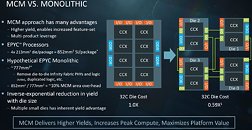- Joined
- Oct 9, 2007
- Messages
- 47,881 (7.38/day)
- Location
- Dublin, Ireland
| System Name | RBMK-1000 |
|---|---|
| Processor | AMD Ryzen 7 5700G |
| Motherboard | Gigabyte B550 AORUS Elite V2 |
| Cooling | DeepCool Gammax L240 V2 |
| Memory | 2x 16GB DDR4-3200 |
| Video Card(s) | Galax RTX 4070 Ti EX |
| Storage | Samsung 990 1TB |
| Display(s) | BenQ 1440p 60 Hz 27-inch |
| Case | Corsair Carbide 100R |
| Audio Device(s) | ASUS SupremeFX S1220A |
| Power Supply | Cooler Master MWE Gold 650W |
| Mouse | ASUS ROG Strix Impact |
| Keyboard | Gamdias Hermes E2 |
| Software | Windows 11 Pro |
AMD, presenting at a HotChips talk, packed with VLSI gurus, defended its decision to make AMD EPYC enterprise processors in the socket SP3r2 package a multi-chip module (MCM) of four 8-core "Summit Ridge" dies, rather than building a monolithic 32-core die. For starters, it stressed on the benefits of a single kind of silicon, which it can use across its performance-desktop, high-end desktop, and enterprise product-stacks; which translates into higher yields. "Summit Ridge" is the only CPU silicon based on the "Zen" micro-architecture, with the company giving finishing touches to the second silicon, codenamed "Raven Ridge," which will power mobile and desktop APUs. AMD has to pick the best-performing dies out of a common bin. The top 5% dies go into powering the company's Ryzen Threadripper HEDT processors, and a higher percentile go into making EPYC.
The relatively smaller 8-core common die has an inherently higher yield than a larger chip due to the rule of inverse-exponential reduction in yield with increasing die-size. This, coupled with the R&D costs that would have gone into developing the hypothetical monolithic 32-core "Zen" based silicon, works out to a significant cost saving for the company. A 4-die/32-core MCM is 0.59X the cost of a hypothetical monolithic 32-core die, according to the company, which is a cost-saving that enables the company to aggressively price its products. The slide AMD used in its presentation also confirms that each 8-core "Summit Ridge" die features four external Infinity Fabric links, besides the one that connects the two CCX units with each other. On a 4-die EPYC MCM, three out of four of those external IF links wire out to the neighboring dies, and one link per die probably wires out to a neighboring socket on 2P machines.

View at TechPowerUp Main Site
The relatively smaller 8-core common die has an inherently higher yield than a larger chip due to the rule of inverse-exponential reduction in yield with increasing die-size. This, coupled with the R&D costs that would have gone into developing the hypothetical monolithic 32-core "Zen" based silicon, works out to a significant cost saving for the company. A 4-die/32-core MCM is 0.59X the cost of a hypothetical monolithic 32-core die, according to the company, which is a cost-saving that enables the company to aggressively price its products. The slide AMD used in its presentation also confirms that each 8-core "Summit Ridge" die features four external Infinity Fabric links, besides the one that connects the two CCX units with each other. On a 4-die EPYC MCM, three out of four of those external IF links wire out to the neighboring dies, and one link per die probably wires out to a neighboring socket on 2P machines.

View at TechPowerUp Main Site









 zen is more efficient than anything Intel has atm, excluding Denverton.
zen is more efficient than anything Intel has atm, excluding Denverton.